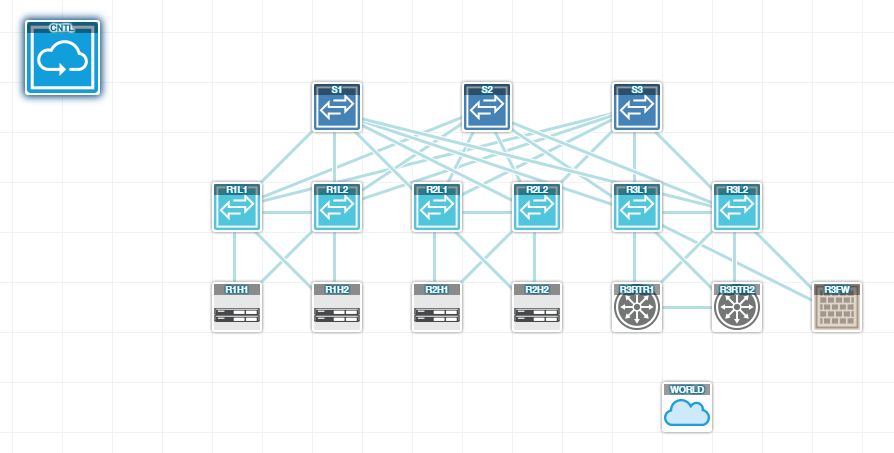I just finished the first lab module on the Big Switch Networks SDN controller. The lab was very well structured and gave me a good feel for how it works and how it would compare to managing a similar Cisco style network. The concepts would take a little getting used to but the overall impression is that the learning curve would not be that steep. The BSN Controller uses a standard Cisco CLI like interface to show and modify the configuration. All components, spine and leaf switches, routers, tenants, etc. are contained in the same configuration file so I can see a CLI solution becoming cumbersome after a while as the file would get very large in a real datacenter. However, being able to look at specifics of the configuration via CLI is always nice and troubleshooting using debug commands is also a great benefit.
The module ended with a review of the GUI which is probably the way to go for day to day operations. Of course in a real productive system, the biggest benefits will come with orchestration and integration into either an OpenStack or VMWare solution.
Here is an excerpt from the configuration for reference based on the following topology…

Big Switch Lab Topology
54 login: admin
admin@54.166.155.75's password:
Last login: Mon Aug 3 06:39:47 2015 from 54.224.58.210
Big Cloud Fabric Appliance 2.6.0 (bcf-2.6.0 #265)
Logged in as admin, 2015-08-03 07:51:42.971000 UTC, auth from 54.224.58.210
10.37.169.132> en
10.37.169.132# sh run
!
! Big Cloud Fabric Appliance 2.6.0 (bcf-2.6.0 #265)
! Current Time: 2015-08-03.07:51:49
!
version 1.0
! ntp
ntp server 0.us.pool.ntp.org
! aaa
aaa accounting exec default start-stop local
! local
local node
interface ethernet0
service openflow
service secure-api
service secure-ns-api
service secure-web
service ssh
service sync
service syslog
service web
! user
user admin
full-name 'Default admin'
hashed-password method=PBKDF2WithHmacSHA1,salt=bfklbm1eiP8UB9Rx2tRbnA,
rounds=10000,Ei1Sj4GiBNZchV707iJ1jrXb
Ca_L26KhmoT5t22cxyg
! group
group admin
associate user admin
! controller
controller
name VirgoSupercluster
! switch
switch R1L1
fabric-role leaf
leaf-group R1
mac 00:00:00:02:00:01
switch R1L2
fabric-role leaf
leaf-group R1
mac 00:00:00:02:00:02
switch R2L1
fabric-role leaf
leaf-group R2
mac 00:00:00:02:00:03
switch R2L2
fabric-role leaf
leaf-group R2
mac 00:00:00:02:00:04
switch R3L1
fabric-role leaf
leaf-group R3
mac 00:00:00:02:00:05
switch R3L2
fabric-role leaf
leaf-group R3
mac 00:00:00:02:00:06
switch S1
fabric-role spine
mac 00:00:00:01:00:01
switch S2
fabric-role spine
mac 00:00:00:01:00:02
switch S3
fabric-role spine
mac 00:00:00:01:00:03
! port-group
port-group FW-01
member switch R3L1 interface R3L1-eth5
member switch R3L2 interface R3L2-eth5
port-group R1H1
member switch R1L1 interface R1L1-eth5
member switch R1L2 interface R1L2-eth5
port-group R1H2
member switch R1L1 interface R1L1-eth6
member switch R1L2 interface R1L2-eth6
port-group R2H1
member switch R2L1 interface R2L1-eth5
member switch R2L2 interface R2L2-eth5
port-group R2H2
member switch R2L1 interface R2L1-eth6
member switch R2L2 interface R2L2-eth6
port-group RTR-01
member switch R3L1 interface R3L1-eth6
member switch R3L2 interface R3L2-eth6
port-group RTR-02
member switch R3L1 interface R3L1-eth7
member switch R3L2 interface R3L2-eth7
! tenant
tenant External
logical-router
route 10.0.0.0/24 next-hop tenant system
route 10.0.1.0/24 next-hop tenant system
route 10.0.2.0/24 next-hop tenant system
route 0.0.0.0/0 next-hop rtr
interface segment Ext-01
ip address 10.0.3.1/24
interface segment Ext-02
ip address 10.0.4.1/24
interface tenant system
next-hop-group rtr
ip 10.0.3.2
ip 10.0.4.2
segment Ext-01
member port-group RTR-01 vlan untagged
segment Ext-02
member port-group RTR-02 vlan untagged
tenant Green
logical-router
route 0.0.0.0/0 next-hop tenant system
interface segment QA
ip address 10.0.2.1/24
interface tenant system
segment QA
member port-group R2H2 vlan untagged
tenant Red
logical-router
apply policy-list FireWall
route 0.0.0.0/0 next-hop tenant system
interface segment App
ip address 10.0.1.1/24
interface segment FW-01
ip address 10.0.5.1/24
interface segment Web
ip address 10.0.0.1/24
interface tenant system
next-hop-group ServiceNode
ip 10.0.5.2
policy-list FireWall
10 permit segment-interface Web any to tenant Red segment App
next-hop ServiceNode
11 permit any to any
segment App
member port-group R2H1 vlan untagged
segment FW-01
member port-group FW-01 vlan untagged
segment Web
member port-group R1H1 vlan untagged
member port-group R1H2 vlan untagged
tenant system
logical-router
route 0.0.0.0/0 next-hop tenant External
interface tenant External
interface tenant Green
interface tenant Red

